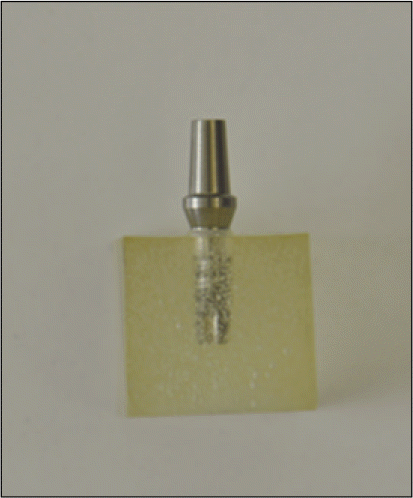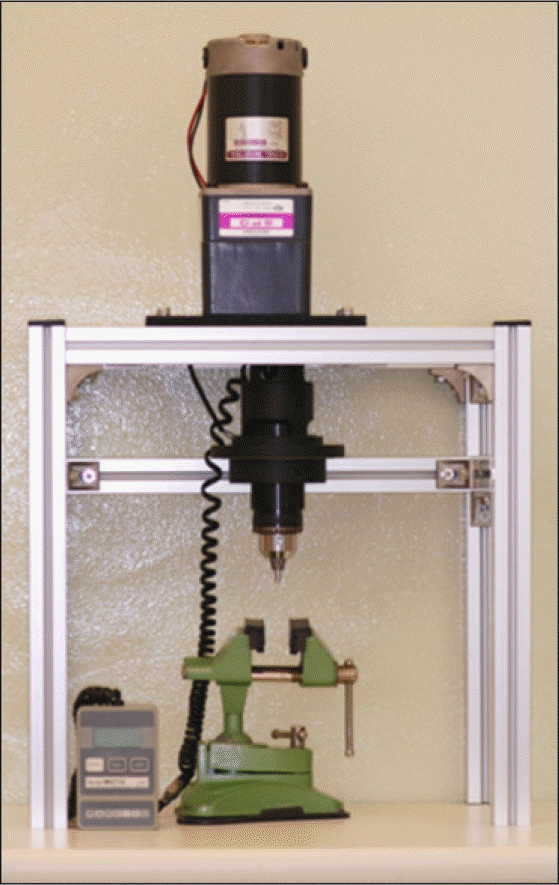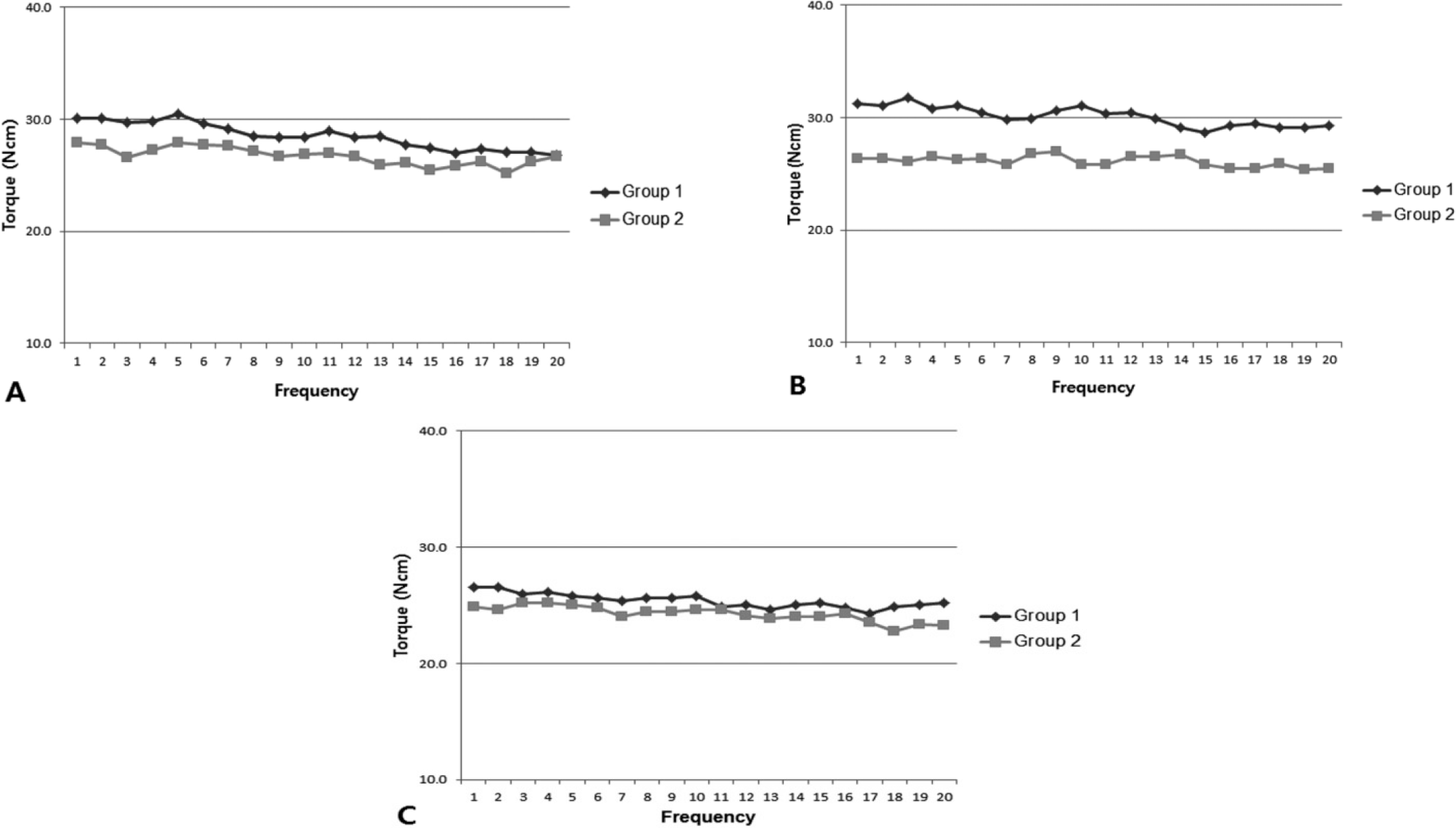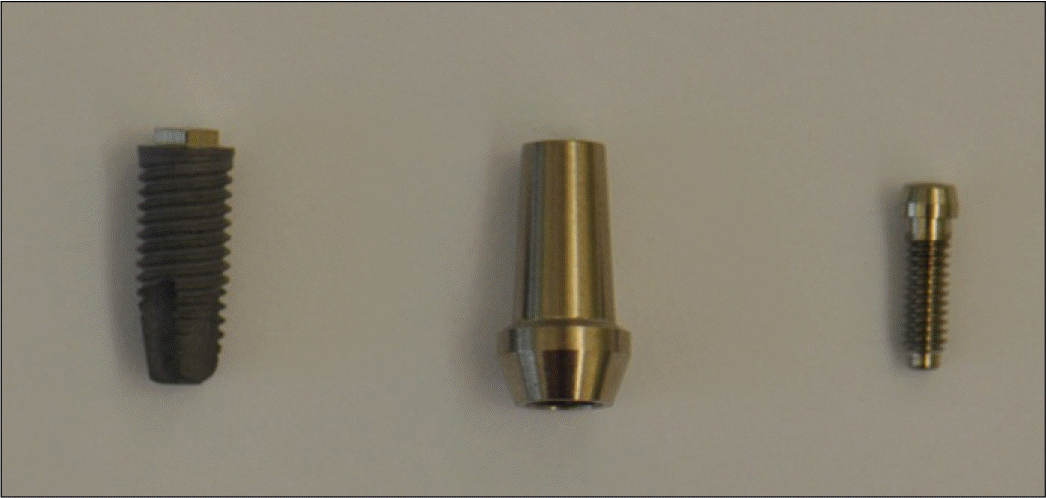Abstract
Purpose
This study was to evaluate the accuracy of how to use the Mechanical Torque-Limiting Devices.
Materials and methods
Three different implant manufacturers (Dentium, Osstem, Shinhung) were prepared for each two implant torque controllers. Divided into two groups depending on the method used for removal torque was measured. Repeated measures of ANOVA test (α =.05) was used as statistics to evaluate the effect of repeated loading number on the removal torque. Independent t-test was used to evaluate the difference in removal torque of two groups.
Go to : 
REFERENCES
1.Jaarda MJ., Razzoog ME., Gratton DG. Ultimate tensile strength of five interchangeable prosthetic retaining screws. Implant Dent. 1996. 5:16–9.

2.Jaarda MJ., Razzoog ME., Gratton DG. Comparison of "look-alike" implant prosthetic retaining screws. J Prosthodont. 1995. 4:23–7.

3.Jaarda MJ., Razzoog ME., Gratton DG. Geometric comparison of five interchangeable implant prosthetic retaining screws. J Prosthet Dent. 1995. 74:373–9.

4.Mitrani R., Nicholls JI., Phillips KM., Ma T. Accuracy of electronic implant torque controllers following time in clinical service. Int J Oral Maxillofac Implants. 2001. 16:394–9.
5.Standlee JP., Caputo AA., Chwu MY., Sun TT. Accuracy of mechanical torque-limiting devices for implants. Int J Oral Maxillofac Implants. 2002. 17:220–4.
6.Vallee MC., Conrad HJ., Basu S., Seong WJ. Accuracy of friction-style and spring-style mechanical torque limiting devices for dental implants. J Prosthet Dent. 2008. 100:86–92.

7.Tan KB., Nicholls JI. The effect of 3 torque delivery systems on gold screw preload at the gold cylinder-abutment screw joint. Int J Oral Maxillofac Implants. 2002. 17:175–83.
8.Dellinges MA., Tebrock OC. A measurement of torque values obtained with hand-held drivers in a simulated clinical setting. J Prosthodont. 1993. 2:212–4.

9.Gross M., Kozak D., Laufer BZ., Weiss EI. Manual closing torque in five implant abutment systems: an in vitro comparative study. J Prosthet Dent. 1999. 81:574–8.

10.Dellinges M., Curtis D. Effects of infection control procedures on the accuracy of a new mechanical torque wrench system for implant restorations. J Prosthet Dent. 1996. 75:93–8.

11.Saboury A., Sadr SJ., Fayaz A., Mahshid M. The effect of aging on the accuracy of new friction-style mechanical torque limiting devices for dental implants. J Dent. 2013. 10:41–50.
12.McCracken MS., Mitchell L., Hegde R., Mavalli MD. Variability of mechanical torque-limiting devices in clinical service at a US dental school. J Prosthodont. 2010. 19:20–4.

13.Standlee JP., Caputo AA. Accuracy of an electric torque-limiting device for implants. Int J Oral Maxillofac Implants. 1999. 14:278–81.
14.Gutierrez J., Nicholls JI., Libman WJ., Butson TJ. Accuracy of the implant torque wrench following time in clinical service. Int J Prosthodont. 1997. 10:562–7.
15.Binon PP. Evaluation of the effectiveness of a technique to prevent screw loosening. J Prosthet Dent. 1998. 79:430–2.

16.Siamos G., Winkler S., Boberick KG. Relationship between implant preload and screw loosening on implant-supported prostheses. J Oral Implantol. 2002. 28:67–73.
Go to : 
 | Fig. 1.Mechanical Torque-Limiting Devices (MTLDs). From top to bottom, head, body, spring, handle. A: Dentium MTLD, B: Osstem MTLD, C: Shinhung MTLD. |
 | Fig. 2.Group 1: Loosen the handle portion of MTLDs. A: Dentium MTLD, B: Osstem MTLD, C: Shinhung MTLD. |
 | Fig. 3.Group 2: Tighten the handle portion of MTLDs. A: Dentium MTLD, B: Osstem MTLD, C: Shinhung MTLD. |
 | Fig. 5.Specimen preparation. Implant fixture to resin block is fixed. Then connect abutment and abutment screw. |
 | Fig. 6.Removal torque value measuring set. This is composed of a digital torque gauge, a specimen loading apparatus, an aluminum framework, and specimen grip device. |
 | Fig. 7.Comparison between Group 1 and Group 2 removal torque value. A: Dentium MTLD, B: Osstem MTLD, C: Shinhung MTLD. |
Table 1.
Test samples with the initial torque, removal torque of each groups




 PDF
PDF ePub
ePub Citation
Citation Print
Print



 XML Download
XML Download